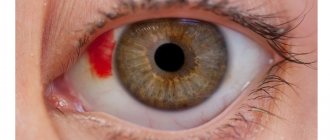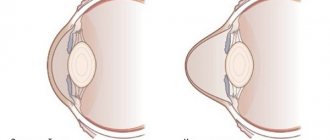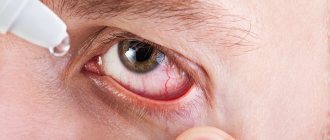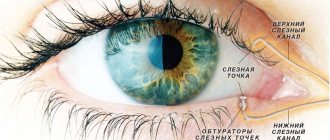Everyone wants to have perfect vision, but this is not always achievable. There are deviations from the norm, pathologies associated with deterioration in visual perception of objects. If visual acuity is normal, the image will be projected onto the surface of the retina. If violations are observed, then the projection goes to areas before or after it. In the second case, we are talking about such a phenomenon as hypermetropia. This disorder also has a second name – farsightedness. The result of the pathology is blurred images of objects and objects that are located in close proximity to a person - up to 1-2 m. The disease has different degrees of severity. Among the patients there are many people suffering from moderate illness.
Definition of disease
Hypermetropia has a more common name - farsightedness. With this disease, the image of objects located in the distance is reflected at a certain point on the retina, and in the area behind it. It is characterized by weak refraction, when there is a strong load on accommodation to display distant objects.
Hypermetropia is a visual impairment where distant objects are seen better than near objects.
Farsightedness and hypermetropia are common among newborns due to the specific structure of the organ of vision. The size of the organ itself is still significantly small for the refractive power of the lens, so the image is distorted towards a hypermetropic deviation. As a rule, before 6 years of age, the eye is fully formed and the disease goes away on its own . Doctors do not prescribe any correction, because... this can harm natural development. If the child has not “outgrown” farsightedness, then treatment is selected.
In addition to the congenital nature of the disease, there is also a natural change in the organ of vision due to age. This farsightedness is called presbyopia and is caused by a change in focal accommodation. The lens becomes less elastic with age, causing it to lose its ability to change curvature when viewing smaller objects.
Like any other disease associated with impaired visual function (astigmatism, farsightedness), hyperopia has its own degrees:
- Weak - up to 3.0 D - is characterized by a slight deviation when viewing objects at a distance, but the perception of objects close up changes significantly. Another concomitant symptom is eye fatigue (asthenopia).
- Average – from 3.25 to 5.0 D – visual function is significantly reduced when examining small objects (reading, working with fine motor skills), distance vision remains good.
- High – from 5.25 and above – vision is impaired when viewing objects at a distance and near.
Farsightedness in children: how it manifests itself
Up to a certain point, it is quite difficult to identify farsightedness in children due to the lack of complaints. Only by the age of 5-6 is a child able to meaningfully explain his feelings to his parents. Until this period, it remains only to indirectly judge the real state of the baby’s vision. Therefore, parents need to know how farsightedness manifests itself in young children.
The child gets tired quickly and begins to be capricious when visual stress increases and when he tries to look at a toy lying close to him. He involuntarily moves the books away from him, trying to look at them. Headaches are also common in farsighted children. They become irritable, whiny, and constantly rub their eyes with their hands.
Causes
There are two main reasons for the development of farsightedness, which can be caused by different circumstances:
- Shortened anteroposterior axis and weakened refractive power of the eye. Most often, this happens due to surgery on the organs of vision, changes in the shape of the lens with age, small eye size, and a slightly curved cornea.
- Genetics. This is a rarer case. The reason for this is heredity from parents and is expressed in a short eyeball.
- Age-related changes.
A correctly identified cause will help provide effective treatment.
Types of hypermetropia
Depending on the root cause of the appearance, age-related and congenital eye pathologies are distinguished. Age-related farsightedness most often develops in people over 45 years of age due to the natural aging process of the body.
Congenital disturbances of accommodation are formed during the development of the baby’s visual organs. This type of refractive error is fraught with the occurrence of various complications: amblyopia, strabismus.
Symptoms
A person suffering from hypermetropia first notices that the ability to see close objects has decreased, and sometimes what is far away becomes blurry.
It is more difficult for young people to determine farsightedness , because our lens can adapt to increase optical power. This is especially difficult to notice with weak and moderate hypermetropia.
When a person gets older, his organs of vision can no longer adapt so well to a decrease in the quality of vision.
So, here are a few main symptoms that can help you determine the presence of this disease:
- My eyes began to tire faster when reading text.
- Eye diseases often appear.
- High eye strain at work.
Read about ptosis of the upper eyelid in the material.
At the first symptoms of farsightedness, consult a doctor immediately.
Degrees of pathology
A person begins to experience a vision problem when the pathology has developed into the second degree.
There are 3 degrees of farsightedness. All of them are characterized by the number of diopters (D) that the visual system lacks for normal functioning:
- Mild hypermetropia is practically asymptomatic. Visual function is impaired up to 2 diopters.
- At a moderate level, vision problems appear that require immediate correction. The violation is 2.5-5 D.
- High degree hypermetropia is characterized by a deterioration in visual function by more than 5.25 diopters. This disease is difficult to cure and sometimes surgery is required.
In a person diagnosed with mild hypermetropia, the visual system, thanks to accommodation, functions normally. But if moderate or high hyperopia is diagnosed, the eyes are not able to cope with such severe dysfunction. In this situation, glasses are selected, with the help of which correction of close and far located objects is carried out.
Possible complications
If you do not take therapeutic measures to correct this problem, you may encounter the following complications:
- The quality of life will drop . A person will not be able to perform ordinary and simple actions, such as reading a book or working on a computer. Any type of activity that requires the participation of the visual organs will be extremely difficult to perform.
- Risk of developing the causes of glaucoma . The intraocular fluid begins to flow worse, so the likelihood of this disease increases. Glaucoma is dangerous because with constantly elevated IOP, atrophy of the optic nerve develops, and this disease, when the organ is completely dysfunctional, causes blindness.
Complications due to hypermetropia are very dangerous, so you shouldn’t start it.
When farsightedness is normal
Due to the nature of how children's eyes work, most babies suffer from farsightedness. This is due to the fact that the eye needs to get used to the world around it, learn to focus on objects - to put it poetically, we can call this process “calibration”. It will take about three years for it to be completed.
However, there is one caveat. Young children are characterized by mild or moderate farsightedness. If a child has poor orientation, does not recognize loved ones, does not react to a toy spinning in front of his nose, and is not able to determine in which direction the speaker is located, this is a reason to suspect that he has a severe degree that needs the attention of an ophthalmologist.
If a severe degree is not corrected at a very young age, the result will be strabismus and possibly lazy eye syndrome.
If a child shows problems with vision, it is better to take him to an ophthalmologist in any case. Only a doctor can determine what will go away on its own and what is better to undergo therapy.
Treatment
There are many ways to treat hypermetropia. Let's look at each of them in more detail.
Medication method
Usually drugs are prescribed as an adjunct to therapy. These are various vitamins and dietary supplements that need to be taken twice a year. They are prescribed by an ophthalmologist, taking into account all your characteristics.
You can find reviews of Japanese eye drops with vitamins here.
Vitamins to improve vision
Surgically
Surgery is generally only necessary in cases of severe forms of farsightedness. Most often, doctors prescribe laser vision correction, because it is the safest and is suitable for almost all patients. This method also completely restores visual acuity, making it possible to completely get rid of complications.
Traditional ways
Everything here is based on the intake of fruits, vegetables and foods with a high content of vitamins. These include blueberries, carrots, lingonberries, various greens, kiwi, cranberries, vegetable oils, and various nuts.
You can also perform simple eye exercises. Take a pencil in your hand. Stretch it forward, and first direct your gaze to foreign objects, then concentrate it on the pencil. Gently bring it at a distance of at least 15 centimeters from your face. Now back, also smoothly, extend your arm. After blinking a little, repeat the exercise. Should be performed at least 5 times.
Find out what foods are good for your eyesight in the article.
Only an ophthalmologist is able to prescribe an effective treatment method to the patient.
Farsightedness in children: classification
Depending on the severity, there are three stages of hypermetropia:
- Weak (up to +2D). The baby sees objects well at a relatively close distance.
- Moderate (+2-+5D). Clear distance vision, poor near vision. Such farsightedness in children over eight years of age is recognized as a pathology.
- High farsightedness (over +5D). Inability to clearly see objects at a distance as well as at close range. Constant wearing of corrective optics is required.
The age of 5-6 years is a transitional period when children develop stable vision. If severe farsightedness was detected earlier, especially when it is a high degree, it is necessary to begin timely treatment.
The direction of treatment and preventive actions is selected taking into account the age and physiological characteristics of the child, as well as the type of course and severity of the disease. The phenomenon of hidden farsightedness in children is also often encountered.
Farsightedness, regardless of the child’s age, causes him certain inconvenience in everyday life. Therefore, it is important to undergo regular medical examinations in order to promptly identify and correct existing refractive errors.
Prevention
A few simple preventive measures may well prevent the disease in question:
- After spending a long time at the computer or reading a book, you need to take walks in the fresh air. This will help relieve eye strain.
- Engage in active sports.
- Do eye exercises every day.
- Be examined by a doctor at least once a year.
Eye exercises according to Zhdanov are here.
Prevention is the key to long-term health of your vision.











